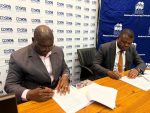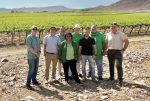Following metallurgical column leaching test work for its Norasa Uranium project in Namibia, Forsys says that extensive follow-up test work is planned.
The primary areas of focus will include additional column tests aimed at assessing a high-pressure grinding roll crushed product, acid consumption, irrigation rate and leach duration, with the objective of achieving an optimal uranium dissolution rate. Literature indicates between 4% to 6% increased metal extractions in heap leach operations with HPGR crushing.
As part of this follow-up test work, ore amenability for bulk ore sorting will be assessed, aimed at upgrading material prior to leaching to enhance recoveries and expedite cash flow and bolster project economics.
The Norasa Uranium Project is wholly-owned by the Company’s 100% subsidiary Valencia Uranium (Pty) Ltd. and comprises the Valencia uranium deposits (held under ML-149) and the Namibplaas uranium deposit (under EPL-3638, application for ML-251) located in the Erongo region of Namibia.
In the results of its metallurgical column leaching test work for its Norasa, the company said completed metallurgical test work supports utilizing heap leaching to recover uranium at Norasa.
A total of 16 metallurgical column leach tests have been completed. Various test conditions were assessed, covering initial scouting tests aimed at evaluating the impact of binder addition, higher irrigation rates and grind size on recoveries, leach kinetics and acid consumption.
Furthermore, uranium extraction rates of up to 87% (crushed with a conventional cone crusher, average of solids and solution-based recovery) were achieved within a leach cycle time of 30 days or less. Sulphuric acid consumption ranged from 17 kg/t to 38 kg/t, depending on operational parameters. This recovery rate is on par with that achieved by other similar type operations with comparable ore type.
“With the integration of higher irrigation rates, binder addition and grind size adjustments, there is an opportunity to optimise the baseline parameters, enhancing leach kinetics, reagent addition and recovery rates,” the company said.
Forsys is initiating the next phase of the test work programme along with ongoing optimisation efforts. The key workstreams will include two further phases of Column Leach tests at SGS with ongoing mineralogical analysis to complete the data evaluation.
These phases of follow up testing are aimed at enhancing the efficiency and effectiveness of extracting the uranium mineralisation from ore samples with a wider head grade range.
The programme is designed to test a range of leaching variables, including crushing by HPGR to assess the impact of the particle cracking effect to expose increased mineral surface area for improved leaching. Column work to date has shown higher uranium grades in coarser fractions of the residue, indicating the majority of mineralisation in the fines has been leached. Physical leaching variables will also be tested for optimising leach conditions.
As part of the programme a boxcut is planned which will enable access to adequate mass of bulk fresh ore material for large scale column leach testing to inform process design.










